September 2, 2020 by Eleanor J. Bader
“For Me, Art Has Always Been a Protest”
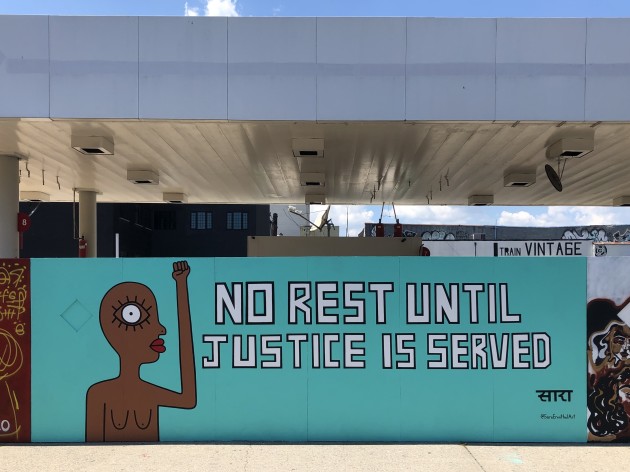 The block-long mural is called the Wall of Justice and it began to take shape on Brooklyn’s Fourth Avenue in Gowanus within days of the police shooting of George Floyd. (more…)
The block-long mural is called the Wall of Justice and it began to take shape on Brooklyn’s Fourth Avenue in Gowanus within days of the police shooting of George Floyd. (more…)
- No Comments
September 1, 2020 by admin
Black Jewish Women Artists You Should Know… Jordana Daumec
Art–whether it be dancing, painting, drawing, film–creates a space for self-examination, helping us to envision possible futures, and better versions of ourselves. And the Jewish month of Elul is traditionally an opportunity for introspection before the High Holidays of Rosh Hashanah and Yom Kippur.
Recognizing the power of art to be transformative, Lilith is highlighting Black Jewish women artists in this time leading up to and through Elul. On Lilith’s platforms you’ll have a chance to experience, share, and celebrate their work.
You can also participate by letting us know (at info@Lilith.org) Black Jewish women creators we should include!
—-
This week Lilith is featuring Jordana Daumec.
Website: https://national.ballet.ca/Meet/Dancers/1st-Soloists/Jordana-Daumec
Jordana Daumec was born in New York City. She trained at Studio Maestro in New York City and Canada’s National Ballet School. Jordana joined The National Ballet of Canada as an RBC Apprentice in 2003 and was promoted to First Soloist in 2015.
What is the comfort food you’re making during the pandemic?
This is an easy answer, challah! I make my husband and me a loaf every week. Such a great way to spend a day. I love the smell of the baking bread, you can see the love that you put into it and it comes out so delicious. I’m sure we’d eat more than one loaf a week if I made us more.

What is the world calling you to be/do in this moment?
Tackling issues of diversity have always been a calling to me but in this time of the pandemic, when we are all home and have more free time, my focus has been on what I can do for my dance community in a positive and constructive way. Starting conversations, bringing awareness, listening, being active to help make change. It’s really wonderful to see so many people coming together to use this time to make a difference.

For what in your life do you feel most grateful?
This is a hard one to limit to just one thing. I’m grateful for the love and support of my husband and family on a daily basis. With their constant love, I feel like I can accomplish anything. I am also grateful that I am in a profession that I love to do. I get to work with amazing people who have had such an impact on me. An example was getting to work with William Forsythe and Crystal Pite this year. It was career changing! Honestly, I can say I feel the Mazels coming down from the stars.
- No Comments
August 30, 2020 by Joan Roth
#Monumental Women: The First Statue of Real Women in Central Park
The Women’s Rights Pioneer Monument in Central Park’s Literary Walk, honoring Sojourner Truth, Elizabeth Cady Stanton & Susan B. Anthony was unveiled on Wednesday, August 26, 2020, at 7:45 AM.
“A few good women stepped forward to create history in the form of a powerful sculpture to affirm the leading role of women in our history, and its historical importance for New York City, and for the character of our nation,” said Manhattan Borough President, Gail Brewer. “When the struggle for this courageous sculpture began, the City of New York had only five specific sculptures on the subject of real women: Joan of Arc, Eleanor Roosevelt, Gertrude Stein, Harriet Tubman, and Golda Meir. None were in Central Park. Monumental Women banned together and set out to break the bronze ceiling, by honoring the three most important women who risked their lives for suffrage. The answer NO came in many forms: The Park is closed to new statues. Women do not want a statue they want a garden. If we say yes to this statue, we will have to say yes to any statue. You have to prove that each of these women had actually set foot into Central Park. Well, it took 70 years to get the vote and only 7 years to get a statue.”
 Close up view of the statue 100th anniversary of women getting the right to vote through the passage of the 19th Amendment.
Close up view of the statue 100th anniversary of women getting the right to vote through the passage of the 19th Amendment.
When Congress passed the 14th and 15th amendments, giving voting rights to African American men, Anthony and Stanton were angry and in turn, opposed the legislation because it did not include the right to vote for women. Their belief led them to split from other suffragists. They thought the amendments should also have given women the right to vote. They formed the National Woman Suffrage Association, to push for a constitutional amendment giving women the right to vote.
In 1872, Anthony was arrested for voting. She was tried and fined $100 for her crime. This made many people angry and brought national attention to the suffrage movement. In 1876, she led a protest at the 1876 Centennial of the nation’s independence. She gave a speech—“Declaration of Rights”—written by Stanton and another suffragist, Matilda Joslyn Gage.
“Men, their rights, and nothing more; women, their rights, and nothing less.”
Anthony died in 1906, 14 years before women were given the right to vote with the passage of the 19thAmendment in 1920.
Sojourner Truth was born into slavery on November 26, 1797, in Dutch-speaking Ulster County, New York, as “Belle” Baumfree. Bought and sold five times, she would become one of America’s leading abolitionist and women’s rights activist. Truth escaped to freedom in 1826. “After I left the house of bondage, I gave myself a new name, Sojourner Truth. When I left the house of bondage I left everything behind. I wasn’t going to keep nothing of Egypt on me, an’ so I went to the Lord an’ asked him to give me a new name. And he gave me Sojourner because I was to travel up and down the land showing the people their sins and bein’ a sign unto them. I told the Lord I wanted two names ’cause everybody else had two, and the Lord gave me Truth because I was to declare the truth to the people.”
>Elizabeth Cady Stanton was born on November 12, 1815, in Johnstown, New York. Daniel Cady, Stanton’s father, was a prominent Federalist attorney who served one term in the United States Congress (1814–1817) and then became both a circuit court judge and, in 1847, a New York Supreme Court justice. Judge Cady introduced his daughter to the law and, together with her brother-in-law, Edward Bayard, planted the early seeds that grew into her legal and social activism. Even as a young girl, she enjoyed reading her father’s law books and debating legal issues with his law clerks. It was this early exposure to law that, in part, caused Stanton to realize how disproportionately the law favored men over women, particularly married women. Her realization that married women had virtually no property, income, employment, or even custody rights over their own children, helped set her course toward changing these inequities.
As a young woman, Elizabeth Cady met and married Henry Brewster Stanton, with Elizabeth Cady requesting of the minister that the phrase “promise to obey” be removed from the wedding vows. She later wrote, “I obstinately refused to obey one with whom I supposed I was entering into an equal relation.” The couple had seven children. The couple first moved to Boston, Massachusetts, then to Seneca Falls New York.
Each of the women are holding something or carrying something. Each are equipped with an object that identifies them as a traditional statue. Elizabeth Cady Stanton, a writer and philosopher, has books by the foremothers of the women’s rights movement under her chair. Susan B, Anthony has her traveling bag, full of documents that she would bring to Stanton’s house to work on speeches with Stanton. In this case, they were fliers from lectures by Sojourner Truth, as well as from women’s conventions and conferences. Sojourner Truth has her characteristic shawl, and her cap, and carries her knitting, which she used as her own self-imaging and messaging. The women corresponded, met at women’s rights conferences, and shared the same stages.
It took 167 years to read the bronze ceiling, in order to make the Real Women Statue happen in Central Park.
Kathy Hochul, the Lieutenant Governor of the State of New York, said, “The journey for women’s rights does not end here in the park – it continues into the future. today is a historic day for women, who have not been properly represented in our nations and in our state’s history. Today all that changes.”
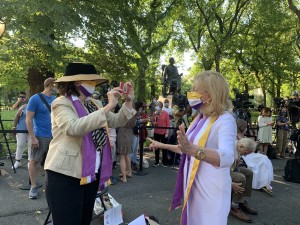
A descendant of Elizabeth Cady Stanton (wearing the hat) with Congresswoman Carolyn Maloney (the leader in Congress to pass the Equal Rights Amendment (ERA) to the Constitution)
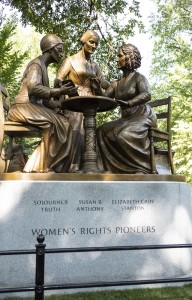
The Sculpture from Afar
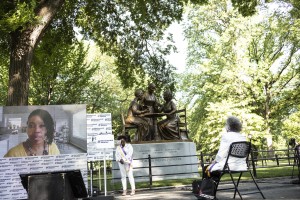
What does this monument mean to me? — It means hope. As a seventh-generation granddaughter of Sojourner Truth, this monument isn’t just here to remind us of our past. It’s not just here to remind us of the works that these three amazing women accomplished. It’s here to remind us of our future, to continue to stand up for what’s right, continue to stand up for what you believe in, continue to stand up for equality, for equal justice — to continue to stand up for what you know is true, what you know is good and what you know is right. It’s here to remind us to continue to stand, as the statue stands, so shall we! – Feminist Plumber, Judaline Cassidy
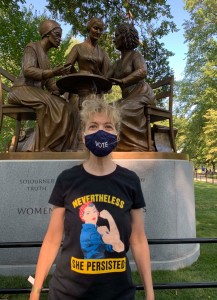
A wonderful outfit worn at the unveiling.
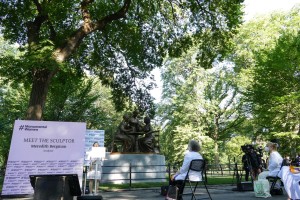
Sculptor Meredith Bergman points out some of the details we will see on the statue. “The first things people will notice,” she says, “is the intensity of the women talking, discussing. Passersby’s will try to figure out what they might be saying. Instead of wondering what they are saying, we hope viewers will be inspired to go read history to learn more.
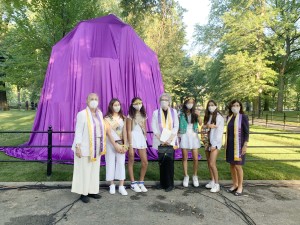
Left to right – Gale Brewer, Manhattan Borough President, girl scouts, Pam Elam, president of Monumental women, girl scouts, Lieutenant Governor Kathy Hochul
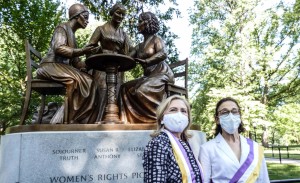
Hillary Clinton and the sculptor Meredith Bergman.
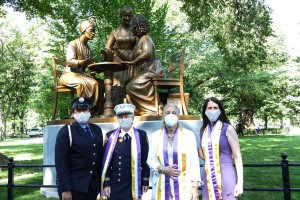
Left to right – Regina Wilson, Brenda Bergman (first female firefighter), Gale Brewer, and Manhattan Borough President, Heather Nestle
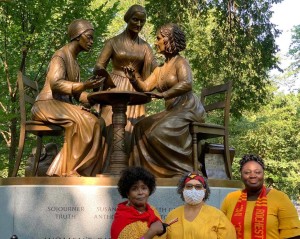
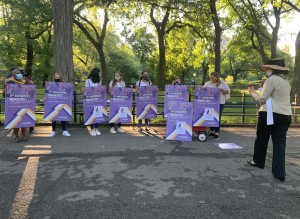
A descendant of Elizabeth Cady Stanton with the girl scouts. Each girl scout has a poster of the new stamp.
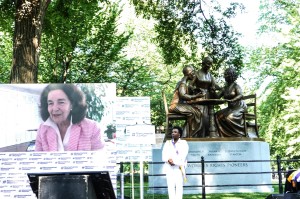
Pictured in the video presented at the unveiling is a descendant of Susan B. Anthony, who says, this statue represents generations of women who have fought for equal rights and are still fighting today. Most importantly we hope that younger women carry on our mission. Thank you so much for making this such a special day/Remember get out there and vote, as a human right.
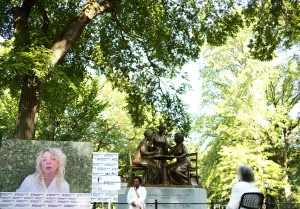
Pictured in the video presented at the unveiling is a descendant of Elizabeth Cady Stanton.
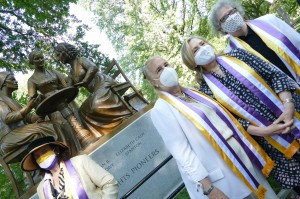
Pictured left to right: Great great-granddaughter of Elizabeth Cady Stanton, Coline Jenkins, Manhattan Borough President, Gale Brewer, former secretary of State Hillary Rodham Clinton, and Monumental Board President, Pam Elam.

Regina Wilson, FDNY Firefighter, singing “America the Beautiful.”

In the summer of 2016, Heather was on maternity leave when she read about the Central Park effort and vowed to be part of it. As president of New York Life Foundation, her company, agreed to support the project with a $500,000 challenge grant, to make the statue a reality. “This generous contribution was in no small part, due to the company’s relationship with Susan B. Anthony.” Nesle explains, “Anthony was one of our first female policy owners. Her father and brother-in-law were agents of the company, and she used the cash value of her policy to actually get the first women admitted to the University of Rochester.” A few months after she joined Monumental Women, Nettle would cast her vote for the first female candidate to run for president Hillary Rodham Clinton.
- No Comments
August 26, 2020 by Yona Zeldis McDonough
Friendships and Race: A New Orleans Coming of Age Story
New Orleans, in all its tawdry glory, is the setting for Iris Martin Cohen’s second novel, Last Call on Decatur Street (Park Row Books, $27.99). After swearing that she’ll never get to return to the Big Easy, Rosemary gets kicked out of college and finds herself back in her hometown, working as a burlesque dancer. Most nights she dulls her private sorrow with a combination of booze, drugs and sex but on the January night in question, her world is cracked wide open and she’s forced to confront the choices—good and bad—that she’s made. Cohen talks to Fiction Editor Yona Zeldis McDonough about how her Jewish protagonist fits into this very Catholic world.
- No Comments
August 25, 2020 by admin
Black Jewish Women Artists You Should Know… Ayeola Omolara Kaplan
Art–whether it be dancing, painting, drawing, film–creates a space for self-examination, helping us to envision possible futures, and better versions of ourselves. And the Jewish month of Elul is traditionally an opportunity for introspection before the High Holidays of Rosh Hashanah and Yom Kippur.
Recognizing the power of art to be transformative, Lilith is highlighting Black Jewish women artists in this time leading up to and through Elul. On Lilith’s platforms you’ll have a chance to experience, share, and celebrate their work.
You can also participate by letting us know (at info@Lilith.org) Black Jewish women creators we should include!
- No Comments
August 24, 2020 by Sharrona Pearl
A Muslim Protagonist’s Angst: Jews Will Relate
Ramy is a show about faith, Millennials, New Jersey, friendship, and porn. It’s a show about searching for purpose, identity, and community even as your identity is assigned to you by outsiders, your community may not be a fit for you, and your purpose is constrained by navigating between those two extremes.
It’s hard to be Muslim-American. It got harder on September 11, 2001, the show reminds us, but it was never easy. It’s hard to be a Millenial who cares about faith but who also cares about being in your 20s, and Having Experiences.
- No Comments
August 19, 2020 by admin
Black Jewish Women Artists You Should Know…Rachel Harrison-Gordon
Art–whether it be dancing, painting, drawing, film–creates a space for self-examination, helping us to envision possible futures, and better versions of ourselves. And the Jewish month of Elul is traditionally an opportunity for introspection before the High Holidays of Rosh Hashanah and Yom Kippur.
Recognizing the power of art to be transformative, Lilith is highlighting Black Jewish women artists in this time leading up to and through Elul. On Lilith’s platforms you’ll have a chance to experience, share, buy and celebrate their work.
You can also participate by letting us know (at info@Lilith.org) Black Jewish women creators we should include!
—
Rachel Harrison-Gordon is an MFA/MBA candidate at NYU Tisch/Stern and a Sundance 2020 Blackhouse Fellow. Rachel’s interest in storytelling evolved through pursuits of perspectives in journalism and in government. She has studied people through quantitative behavioral data and through their stories, and hopes to create films, commercials and music videos that highlight the different ways people come of age. Her work challenges expectations of race, family and addiction.
Prior to NYU, she served as a Presidential Innovation Fellow for the Obama Administration, learning about Veterans and their experience returning home. She worked as a data analyst within a consumer insights group at The New York Times. Rachel graduated from the University of Pennsylvania School of Engineering, where she studied Mechanical Engineering. Broken Bird is Rachel’s first film.
 Instagram: @raawwwwrrrrrrrrr
Instagram: @raawwwwrrrrrrrrr
Website:rachelhg.com // brokenbirdfilm.com/
What’s the best gift you’ve ever given––or received?
Before I thought I could or would be a filmmaker, my partner and in-laws gifted me a beautiful photography camera. It changed the course of my life. When I would listen to music, I would always imagine the images that corresponded to those moments in my mind. Now I was able to create those images, and work the other way around. There’s something so empowering about learning something technical to create something new.
When was the last time you said no?
I was offered to produce a music video with a team who helped give me my start in filmmaking, and with an artist I love and would be eternally grateful to create with. Unfortunately due to COVID and some health circumstances, I had to turn down the opportunity. At least this time, I feel like I’m saying no because of something that matters, and not saying no because I don’t think I’m qualified, which is definitely something that has held me back.
 What is one question that you found yourself asking over and over again this year? What version of an answer are you living your way into?
What is one question that you found yourself asking over and over again this year? What version of an answer are you living your way into?
I used to ask “why does no one hear me? Listen to me?” I’ve found a way to be seen and heard, and to not place so much emphasis on the people who choose not to. I am no longer expending energy on people who refuse to look inside themselves and admit the pain they cause with their limited view of the world.
What is something you need to say? To whom?
To the Black girls everywhere, to the mixed girls, to the Black-Jewish girls – your life is special and valid. People will try to put you into a box so their world-view isn’t shook. Don’t let them do that, don’t let that effort subdue or censor who you are. We are all here and have something to offer. Believe in yourself, especially when you’re getting constant signals and discouragements not to.
- No Comments
August 13, 2020 by Yona Zeldis McDonough
Daphne Merkin on the Nature of Love and Lust
Daphne Merkin is an essayist known for her take—at once both ferociously observant and fiercely introspective—on everything from depression, spanking during sex and the importance of handbags. In 22 Minutes of Unconditional Love (Farrar, Straus & Giroux, $26)) her first novel in more than 30 years, Merkin turns her gimlet-eyed attention to Judith Stone, a young book editor in New York City who has not yet had her first real reckoning with love—or with the erotic charge that often fuels it.
Enter Howard Rose, the somewhat older attorney she meets at a party. Howard arouses her in ways she’s never before experienced and very quickly, she’s putty in his hands. That he’s inclined to insult, undermine and emotionally abuse her only makes him more desirable. Merkin talks to Fiction Editor Yona Zeldis McDonough about the nature of lust, love and whether the two can ever truly be reconciled.
- No Comments
August 13, 2020 by Eleanor J. Bader
A History Professor and her Homeschool Co-Op
Four months ago, history professor Karen Miller thought she’d be spending her sabbatical living and working in Manila as a Fulbright scholar. That, of course, was before the coronavirus became an international pandemic and upended her plans, forcing her to make several major decisions, including whether to leave the Philippines and return to her home in Brooklyn, New York.
Miller ultimately did return—on March 14th. Since then, she and a group of friends have created Homeschoolcoop2020.com, a free, online educational program for children and their caretakers. As of mid-August, the Coop has offered hundreds of diverse classes, some of them single sessions and others ongoing. To date, the range has included yoga, basic sewing, beginning Latin for high school students, intro to chess, human sexuality for middle schoolers, the history of the Panama Canal, drawing, French, and poetry—both writing and appreciating.
Miller recently spoke to Lilith’s Eleanor J. Bader about the Coop’s formation and exponential growth.
- No Comments
August 11, 2020 by admin
Black Jewish Women Artists You Should Know…Jessica Valoris
Art–whether it be dancing, painting, drawing, film–creates a space for self-examination, helping us to envision possible futures, and better versions of ourselves. And the Jewish month of Elul is traditionally an opportunity for introspection before the High Holidays of Rosh Hashanah and Yom Kippur.
Recognizing the power of art to be transformative, Lilith is highlighting Black Jewish women artists in this time leading up to and through Elul. On Lilith’s platforms you’ll have a chance to experience, share, buy and celebrate their work.
You can also participate by letting us know (at info@Lilith.org) Black Jewish women creators we should include!
—
 Jessica Valoris is a multidisciplinary installation artist who weaves together sound, collage, painting, sculpture, and facilitated ritual to build installations and experiences that have been described as sacred, intentional, and activated. She’s inspired by Afrofuturism, metaphysics, and historical memory.
Jessica Valoris is a multidisciplinary installation artist who weaves together sound, collage, painting, sculpture, and facilitated ritual to build installations and experiences that have been described as sacred, intentional, and activated. She’s inspired by Afrofuturism, metaphysics, and historical memory.
- No Comments
 Please wait...
Please wait...